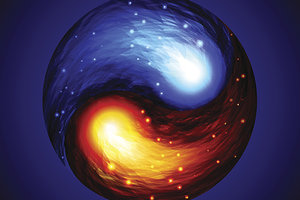Often the root of our problems come not from what we can identify and explain, but from a deeper, hidden place. This is true for both physical problems as well as mental-emotional issues.The Qi within our bodies that is conscious (Ying qi) and most easily accessible is that which flows through the twelve Primary Channels, which most modern acupuncturists favor in clinical practice.
Symptom-ology
Chapter 63 of the Su Wen describes how pathology can "overflow" into the "large network vessels." The result of which is the generation of "strange diseases." Symptoms tend to translocate from one side of the body to another. Pathology in these channels also creates a tendency "to have sadness, be frightened and unhappy."
 Since these problems are not located in the Primary Channels, treatment requires the use of "the large network Vessels," thought to be the Divergent Channels. Treatment of which requires a special type of needling which Chapter 63 calls "misleading piercing." Various traditions interpret Chapter 63 differently. The tradition I come from, disseminated by Jeffrey Yuen, interprets the "large network vessels" to be the Divergent Channels, and says the type of needling appropriate for these collaterals is "three-time needling."
Since these problems are not located in the Primary Channels, treatment requires the use of "the large network Vessels," thought to be the Divergent Channels. Treatment of which requires a special type of needling which Chapter 63 calls "misleading piercing." Various traditions interpret Chapter 63 differently. The tradition I come from, disseminated by Jeffrey Yuen, interprets the "large network vessels" to be the Divergent Channels, and says the type of needling appropriate for these collaterals is "three-time needling."
Understanding Hidden Qi
To understand the Divergent Channels and their potential, Chapter 63 is very important. Not only does it tell us how to treat the Divergent Channels, it also elucidates the idea of "hidden qi," explaining why mysterious, moving, and mutating symptoms occur in the body. To understand the acupuncture collaterals, we must understand the concept of "hidden qi" or the process of "latency."
Nguyen Van Nghi's translation of the Ling Shu presents an important discussion regarding "hidden qi." Chapter 58 entitled "Pirate Wind" says "there are people who are carriers of "latent perverse humidity" hidden within [their bodies]," causing them to become sick for no apparent reason and to experience strange and sometimes strong symptoms from relatively mild external or internal stressors like "sudden joy or upset."
It seems as if the person has been "possessed by a ghost," becoming suddenly ill and mentally unstable. The cause of these symptoms however is "latent perverse energy that has not yet manifested," causing a type of oppositional friction between pathology and the body's internal qi and blood. It is interesting to note that symptoms associated with "large network vessels" in Chapter 63 of the Su Wen are somewhat similar to those associated with the Extraordinary Vessels in the Nan Jing.
Vessel Pathology
Chapter 28 of the Nan Jing describes pathology of the Wei Vessels manifesting as an extreme sense of discomfort, heartache and even madness. The inability to "support one's stature" and "fits of cold and heat" are also associated symptoms. Chapter 62 of the Su Wen also mentions the Extraordinary Vessels, in this case the Qiao Vessels, saying: "When in case of a disease [where] the location of the pain is unknown, to pierce the two [Qiao] vessels is best." The chapter goes on to suggest treating "by applying a misleading piercing." How do we synthesize all of this information? And what is "misleading piercing" (or "three-time needling" as Yuen suggests)?
We can be certain an intimate connection exists between the "large network vessels" and the Extraordinary Vessels, which the Nan Jing describe as "ditches" to contain unresolved pathology from the Primary Channels. Some even say the two channel systems may be one and the same. However if we believe the "large network vessels" to be the Divergent Channels as Yuen suggests, by treating these collaterals we can address mysterious diseases in the body caused by "latent" or "hidden qi." We can also potentially treat mysterious mental-emotional disorders. Yuen describes "three-time-needling," the needling style he associates with the Divergent Channels as relating to needling depth.
Chapter 11 of the Ling Shu describes the Divergent Channels as having upper and lower "confluent points." These points are where the yin and yang channels within each Element meet. For example, the Bladder and Kidney Divergent Channels (Water Element) share points of confluence at BL-40 "Wei Zhong" and BL-10 "Tian Zhu." These points act like opening points for the Divergent Channels, where a specific "lock-and-key" needling must be administered to activate the channels.
The Divergent Channels make connection between Yuan Qi, the deepest layer of qi in the body, and Wei Qi, the most superficial layer of qi. The concept of latency is that the body translocates pathology from the external Wei level of the body and deposits it into the Yuan, which anatomically manifests itself in the bones and joints of the body, as well as the other "Curious Organs": the uterus, prostate, brain, blood vessels etc.
Three-Time-Needling
The three-time-needling technique is illustrative of our intention in using the Divergent Channels to treat latent conditions. To stimulate Wei qi activates the body's capacity to detox. By directing Wei energy into the Yuan, we are encouraging removal of latent pathology from deep anatomical places where it is hiding.
The third part of the needling technique tells the body to send pathology out through the portals of elimination: the respiratory, urinary or digestive system: all aspects of the Wei level of the body.Three-time-needling on the confluent points is the first step in treating a Divergent Channel. The art of the acupuncture treatment continues with other accompanying points added to complete the treatment.
Click here for more information about Nicholas Sieben, LAc.




